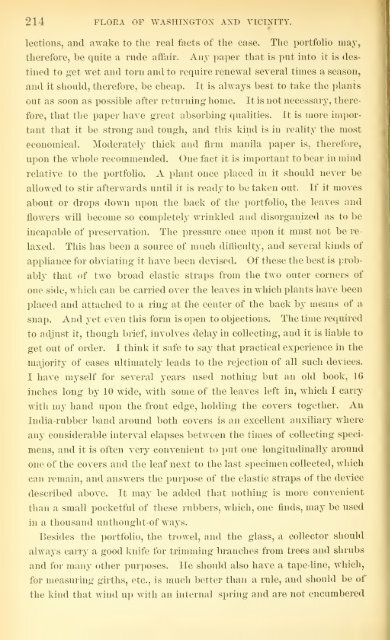Bulletin - United States National Museum - Smithsonian Institution
Bulletin - United States National Museum - Smithsonian Institution
Bulletin - United States National Museum - Smithsonian Institution
You also want an ePaper? Increase the reach of your titles
YUMPU automatically turns print PDFs into web optimized ePapers that Google loves.
214 FLORA OF WASHINGTON AND VICINITY.<br />
lections, and awake to the real facts of the case. The portfolio may^<br />
therefore, be quite a rude afi'air. Any paper that is put into it is des-<br />
tined to get wet and torn and to require renewal several times a season,<br />
and it should, therefore, be cheap. It is always best to take the plants<br />
out as soon as possible after returning home. It is not necessary, there-<br />
fore, that the paper have great absorbing qualities. It is more impor-<br />
tant that it be strong and tough, and this kind is in reality the most<br />
economical. Moderately thick and firm manila paper is, therefore,<br />
upon the whole recommended. One fact it is important to bear in mind<br />
relative to the portfolio. A plant once placed in it should never be<br />
allowed to stir afterwards until it is ready to be taken out. If it moves<br />
about or drops down upon the back of the portfolio, the leaves and<br />
flowers will become so completely wrinkled and disorganized as to be<br />
incapable of preservation. The pressure once upon it must not be re-<br />
laxed. This has been a source of much difficulty, and several kinds of<br />
appliance for obviating it have been devised. Of these the best is prob-<br />
ably that of two broad elastic straps from the two outer corners of<br />
one side, which can be carried over the leaves in which plants have been<br />
placed and attached to a ring at the center of the back by means of a<br />
snap. And yet even this form is open to objections. The time required<br />
to adjust it, though brief, involves delay in collecting, and it is liable to<br />
get out of order. I think it safe to say that practical experience in the<br />
majority of cases ultimately leads to the rejection of all such devices.<br />
I have myself for several years used nothing but an old book, 16<br />
inches long by 10 wide, with some of the leaves left in, which I carry<br />
with my hand upon the front edge, holding the covers together. An<br />
India-rubber band around both covers is an excellent auxiliary where<br />
any considerable interval elapses between the times of collecting speci-<br />
mens, and it is often very convenient to put one longitudinally around<br />
one of the covers and the leaf next to the last specimen collected, which<br />
can remain, and answers the purpose of the elastic straps of the device<br />
described above. It may be added that nothing is more convenient<br />
than a small pocketful of these rubbers, which, one finds, may be used<br />
in a thousand unthought-of ways.<br />
Besides the portfolio, the trowel, and the glass, a collector should<br />
always carry a good knife for trinmiiug branches from trees and shrubs<br />
and for many other purposes. He should also have a tape-line, which,<br />
for measuring girths, etc., is much better than a rule, and should be ol"<br />
the kind that wind up with an internal spring and are not encumbered

















